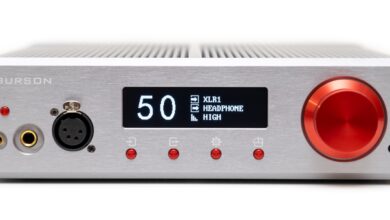Benchmark HPA4 Review – The One to rule them All!
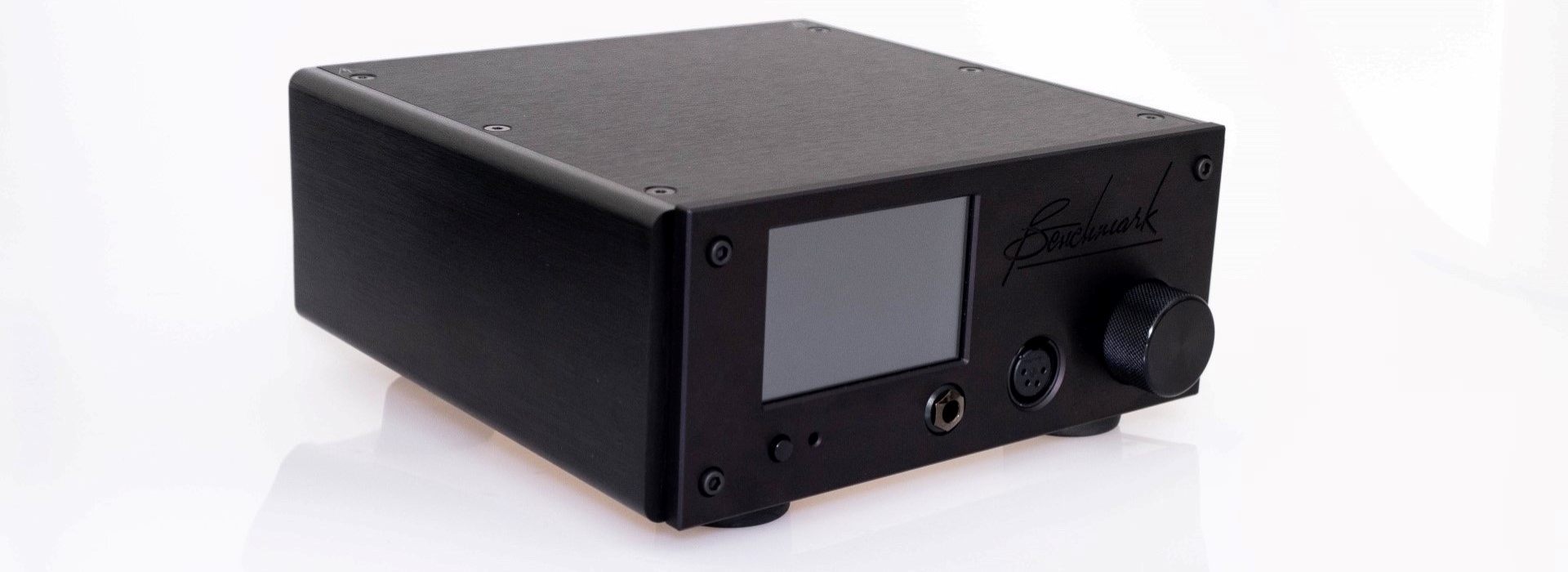
Disclaimer: Benchmark HPA4 together with DAC 3 HGC were loaned to me from the local distributor. Both will be returned back after the test period ends.
My video review:
Before starting my actual review, I just want to remind you that headphone listening at the Hi-Fi level is a big part of my life. I purchased my first headphone amplifier back in 2006 when just mentioning “a headphone amplifier” in the audiophile circles would rise both eyebrows and suspicion of sanity, today having one is a must have if you care about headphones in general. Since then, I am swapping headphone amps quite often, since all of them had small or big flaws.
I was a solid-state guy, then I moved to tube-based designs, then I moved back to solid state electronics and I think I will remain devoted to them for their precision, timing and control.
Today, is a very special day for me, since I believe I am hearing the best overall performance out of my headphones and the distance performance-wise between HPA4 and my second-best headphone amp is Night and Day!

It all started just few years ago when an American company known for it surround technologies and high-fidelity audio and visual reproduction standards for movie theaters announces a breakthrough amplifier circuit called Achromatic Audio Amplifier (or AAA for short). That company is THX, Yes, that one.
So, what is so special about it and why should you care about it? The shortest answer is that this AAA patented feed-forward error correction topology will nullify conventional distortion to unprecedented low levels that were never achieved until this time.
In layman’s terms it means this THX AAA based amplifier will have the lowest noise available and the higher signal-to-noise ratio for the best dynamic range.
Remember TPA6141 based high-end headphone designs? Or the ones based on OPA1622 or LME49600? Does this ring a bell to you? I am seeing those chips very often from mid-range to high-end headphone amps and that is because theoretically speaking in the best ever scenario those can achieve up to -130 Total-Harmonic-Distortion (THD) – an impressive number if you ask me.
The thing is, those mad scientists at THX developed the AAA-888 chips that can achieve almost -150 db of THD! A 20 dB increase in SNR was unheard of!
Here is a graph that will tell you more about the performance of THX chips compared to its best competitors.

THX developed 3 ranges from mobile products, to audiophile and super high-end designs. I’m attaching another graph that will tell a bigger story.

Remember the Massdrop X THX-AAA-789 headphone amplifier that made big waves in the headphone community, that is still out of stock to this day? That one is powered by THX-AAA-788 chips.
However, what I am testing today is the only headphone amplifier on the marked that is based on the top of the line dual-mono THX AAA-888 chips.
Ladies and Gentlemen, please meet the mighty Benchmark HPA4!

Inside the Box
Unboxing experience is quite good, it came double boxed of course, HPA4 is protected by a thick foamy roll-cage, very much like other components of this caliber.
Inside you’ll find a locking power cable (a first time for me), a mini to mini analog cable (1/8” to 1/8”) working as a 12V trigger cable between HPA4 and other Benchmark made audio components like their DAC offerings, there are also two spare fuses and an optional metal remote control (a 100 USD accessory).
After seeing the 58-page instruction manual, I realized how serious Benchmark is about their products and I sincerely recommend checking it out since I learned few tricks from it.
HPA4 comes in two versions: in an all-black anodized aluminum case that I am having today or one with a silver face-plate. I think I like the silver one the most, but I didn’t have a chance to choose and got the black one.
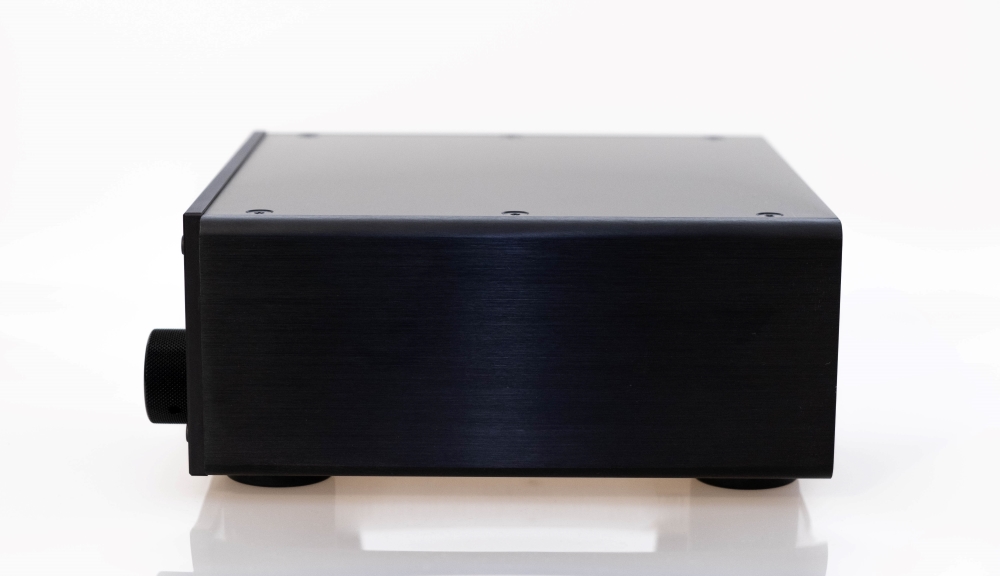
Design & Build Quality
Like other audio components designed and made by Benchmark, HPA4 has an impeccable build quality top to bottom.
The thick metal case works as a giant heat-dissipation system, even the front panel uses a thick aluminum cover.
The amp has a quite small foot-print, it is smaller than Aune S7 PRO and much smaller than my former Audio-GD Master 9 reference headphone amp. Being compact it can be easily integrated into tiny offices; I think it looks impressive put on top of the DAC 3 HGC.
At this size it is quite unusual having 8 lbs (3.7 kg) weight, small body but heavy weight for sure.
The CNC milled front panel houses a very big and feature packed touch-screen LCD, a ¼” (6.35 mm) single ended headphone out, a 4-pin XLR balanced headphone out, a standby/mute button and a very special 256 step fully-balanced relay-controlled volume pot, will write about that one in a minute. Underneath it 4 massive rubber feet can be spotted; those will surely absorb any unwanted micro-vibrations.
I didn’t know I would love the touch-screen so much, it is incredible how many features and settings can be controlled from there. I never seen such an advanced feature-set on a 100% analog headphone amp. From there you instantly mute any of the output, you can instantly lower the output by 20 db, select the desired input or output, you can even rename the analog inputs so you know what are you listening to. If your audio source has a lower power output, you can boost its signal by up to 10 db, or in case your source has super-hot power output, you can lower it down by 10 db. There are other, many other settings that I will skip for now.
I dreamed of a headphone amp that would have two balanced XLR inputs on the back so I could connect two balanced sources at once without even touching the cables or rearranging my setup. So far, HPA4 is the first amp to offer me that. Now, the absolutely coolest thing is that is has another 2 pairs of unbalanced inputs for a total of 4 pairs! In a speaker-based system it will offer an unbalanced output, a balanced stereo output, and a mono output. There are also two 12V triggers in case you’ll want to attach it to other Benchmark components and control all of them with a single remote. That’s neat! isn’t it?

Technology inside HPA4
So far, HPA4 is the first THX-AAA-888 dual mono equipped headphone amplifier on the market and as such it doesn’t have any real competition. HPA4 is truly a no compromise pre-amplifier and headphone amplifier and Benchmark is offering a bunch of measurements to prove that.
THX AAA modules are reducing harmonic, intermodulation and crossover distortion by 20 to 40 dB offering a true to life, realistic and fatigue-free listening experience. It accomplishes that by using a patented feed-forward topology to null conventional distortion and noise levels, resulting in the world’s most linear amplifier. THX AAA allows the amplifier to reach its maximum output power and SPL without production distortion that normally would happen in traditional amplifiers.
The THX-888 chips will deliver up to 6W of power into 16 Ohms, up to 11.9 Vrms into 300 Ohms and up to 1.5 Amperes! Since you can easily damage your headphone with those numbers, Benchmark incorporated several protection systems to avoid that from happening.
These include DC detection, short-circuit detection, over-current protection, over voltage protection and thermal protection. There isn’t a single headphone amp on the market that will offer the same protection systems. I’m loving it already!
All that power will mean nothing if there isn’t a wide bandwidth and speed to deliver all that instantly to your headphones or to the power amplifier. The bandwidth of HPA4 extends from 0.01 Hz to over 500 kHz! This means HPA4 will deliver a very precise amplitude and phase accuracy over the entire audio bandwidth. It seems it’s time to upgrade my hearing apparatus with bat ears…
Since a uber-low noise amplifier will need an uber-low noise volume pot to preserve all the dynamic range and all the bits of the digital source, Benchmark developed an advanced relay-controlled volume pot. In short, it all was possible by using four 256-step relay-controlled attenuators and another four 16-step relay-controlled boost amplifiers. Together these are forming two fully-independent and fully-balanced stereo volume controls. One dedicated for the line-out (pre-amplifier) and one for the headphone amp. Each has a +15dB to -122 dB range in 0.5 steps. The volume controls feauture very high-precision metal film resistors (0.1% tolerance), gold contact relays and fully buffered inputs and outputs. Did it catch your attention yet?

Test Equipment
Once I borrowed the HPA4 I thought why not try the DAC3 HGC as well and use both together. Since HPA4 has 4 analog inputs on the back I thought why not use another 2 digital sources and have a fun evening comparing all the sources.
In the end my test equipment resumed at: Benchmark DAC3 HGC, Matrix X-Sabre Pro, Matrix Element X and Mytek Brooklyn DAC+ all connected to the HPA4. I mostly listened to Audeze LCD-4Z and to Quad ERA-1 headphones via the balanced output, but for fun I also tried a pair of Sennheiser HD660S and few very sensitive IEMs that I am fond of.
Before listening to some tunes Benchmark strongly recommends bypassing the volume control of you digital or analog audio source and leave all that to the advanced and precise volume control of the HPA4.
If you have a Benchmark DAC 1, 2 or 3 of any type you will also need to do the following steps:
- Connect it to the XLR-1 input of HPA4, go to the remote settings in the menu and select “Benchmark DAC on XLR1” so you can control both with the same remote.
- The internal output jumpers of DAC1, 2 or 3 will need to be set at 0 dB
- On the DAC1, 2 or 3 on the front panel press and hold for 3 seconds the DIM/MUTE button until the motorized volume pot moves to the 2 o’clock position and the HT led-light engages
If you did all that, your Benchmark DAC will completely bypass its volume control with the HPA4 more-advanced one.
The same should be done with your other digital or analog sources, bypass the volume or max it out.
OK fellas, its time to take a listen.
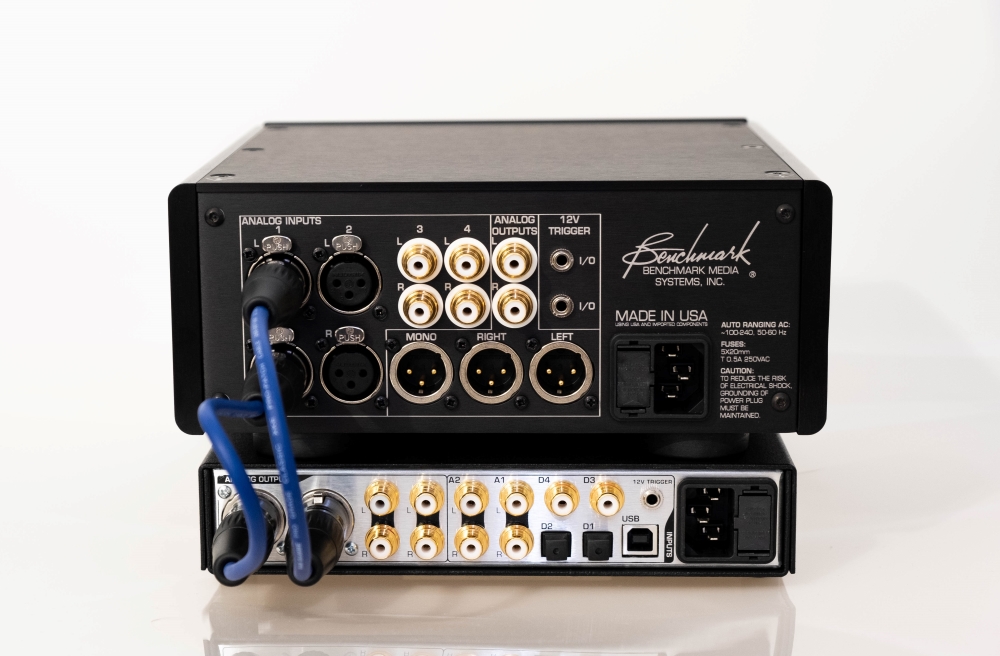
Sound Performance
The biggest compliment I can give to it is that I felt like I upgraded my personal Matrix X-Sabre Pro 1800 USD DAC with a much pricier one as it doesn’t sound at that price anymore!
It never crossed my mind that I will hear new nuance, more hidden information out of my favorite tunes that I am listening to more than 15 years. Every single track I played shown me that there is much more that meets the eye (the ear?), every note was better defined, having a very strong leading-edge like I never heard before. It is like my favorite bands suddenly improved their recording and mastering equipment, there is more of Everything.
Upon receiving it and powering it On, a positive energy rushed into my blood-stream as I felt like am listening to a real-life performance without a single trace of grain or harshness. At last and I don’t need to close my eyes anymore to hear all that hidden information and tiny amounts of air moving in the room.

Resolution & Transparency
When it comes to transparency and resolution HPA4 is doing all that on a such a level, that the second best headphone amp is miles away from it. Words of praise are not enough to tell you how transparent and believable HPA4 is sounding. I just upgraded my source and headphones as well to the highest possible level.
When I tested the Headamp Gilmore Lite Mk2 I knew I was hearing something special in terms of transparency and resolution, but HPA4 trounces it like it’s nothing. Put it simply this way, with HPA4 you will be listening to your source and nothing more. Any change in the downstream equipment, like other source, a cable swap, a different power outlet will be immediately felt with HPA4 in your chain.
The funny thing is I hear more of absolutely everything, even much more treble information and yet not a single trace of brightness/harshness, how that can be possible?

Acoustic Tonality
HPA4 possesses an incredible fluidity and acoustic tonality. Remember when you first heard a high-quality DSD recording and everything sounded just smoother, easier going, with zero stuttering (like it happens sometimes on 16-bit PCM material)? This is exactly how HPA4 is sounding, but this time on PCM 16-bit material as well.
All that bandwidth under its belt and all that speed paid off Big Time! HPA4 to me is bonding the musical notes together with incredible fluidity. It has a super smooth, harsh-free and tireless presentation.
I played an old folk-rock recording that I am very fond of and I immediately heard few tiny details that I never thought are there and the air mass moved so much more subtlety, it was like I am hearing this album for the first time. It gave me a feeling of fluency and a touch of naturalness and unsurpassed reality, it almost made me dizzy.
Transient Response
Since HPA4 is having the widest bandwidth and the best transparency, listening to some faster hard kicking music is like you are fighting in the octagon with your hands handcuffed. Every sound kicks you from different angles like crazy. The speed, impact and slam are completely on another level!
Here’s a fun fact: Sennheiser HD660S in the headphone kingdom are considered to be slow and not as fun and to some degree with other headphone amps – that is true. Attaching the HD660S even to the single ended ¼” output is like headphone drivers suddenly improved their engine and working principle as they start to be impactful and hard hitting.
Even with them I am hearing a tremendous slam and some serious speed that will rival even the best planar-magnetic headphones. Do you think your headphones are slow or boring sounding, HPA4 will unleash the best they can offer.
I finally put some electronica and I was immediately astonished by the deep reaching bass notes that had the hardest grip and the best control so far. Without a doubt, HPA4 exceeded my expectations and surpassed any headphone amp I know of in terms of transient response and slam.

Background Noise & Harmonic Distortion
If you ever read at least one of my headphone amp reviews from around here you probably know how much I value sensitive IEM compatibility and background noise of a desktop headphone amp.
To this day there were many designs that had a very low noise floor but none of them were completely noise-free with IEMs, not a single one.
Do you know how much noise HPA4 outputs at maximum volume? 1.9 uV! The lowest I’ve seen so far was 3 uV! HPA4 without a doubt has the blackest background, the cleanest and the one that just gets out of the way of your music.
Same will the said about harmonic distortion, at about -147 dB of noise I am listening to the limitations of my DAC and of my headphones, because this amp can offer so much more. With HPA4 sky is the limit.
Soundstage Size & Depth
Having a really sharp outline and leading edges, focusing on a single note in a crowded passage is not even difficult. With all that transparency, airiness and zero background noise to me HPA4 is having the most life like depth I encountered with headphones. It is actually unbelievable how easy I am perceiving depth information and how much air mass HPA4 can move in an instant. Soundstage is not artificially enhanced to be super wide; it is naturally wide but not super expanded like it is happening with all-tube designs. To me it sounds much wider than typical solid-state designs and deep as Mariana Trench.
Listening to both planar-magnetic headphones on the 4-pin balanced out everything floats around me with a very focused and centered performance. It is quite unusual hearing depth information on all X, Y and Z axes. Other amplifiers would shine bright on soundstage width, others will have a taller stage, others will have it deep but not too wide. HPA4 changes that rule with lots of air around my head, it’s tall, wide and deep sounding.

Frequency Response
Here’s another fun thing: with HPA4 I don’t need to mumble about frequency response. I don’t need to mention sub-bass, mid-bass, lower or upper midrange or any of the treble ranges. I would be repeating myself in all those sentences.
Simply put, it has the widest frequency response I ever encountered in a headphone amp, it’s simple like that. I know I sound like a maniac or fanboy, but I dare and encourage you, if possible take a listen for yourself and realize how extended and linear this one sounds.
Deepest sub-bass, with absolute levels of control and grip, with tons of layers around those bass notes? Check!
Natural, life-like midrange, deep sounding and soul-reaching voices with crazy guitar plucks and natural decay of the notes? Check!
Super extended in the subsonic treble area with tiny dynamic swings and micro-detail information with absolutely zero brightness? Check!
Can you ask for more? You can’t.
Amplification factor
Now, both Audeze LCD-4Z and Quad ERA-1 are not the hardest to drive headphones around here. With them on the balanced out, I still had about 25 dB of headroom left and I do listen very loud. I will be testing it with a pair of Sennheiser HD820 shortly (in a week or so) but I do believe the same will happen with them.
With Sennheiser HD660S even on the SE it was an easy game, don’t get me even started with my very sensitive IEMs, they just shined on it.
With all those I’ve heard absolute levels of diaphragm control, on any track, at any time of the day HPA4 was lightning quick and slammed like thunder.
I presume headphones like Audeze LCD-4, HifiMan HE-6SE or Susvara will be driven at the fullest potential without a problem.

Headphone Pairings
This is an easy one. Since, HPA4 doesn’t have a character of its own, it stays completely away from the musical performance, it just isn’t there as an amplifier, you see it but you cannot hear it because you are listening to your source and to your headphones or speakers.
If a headphone will not sound to your liking on HPA4, it is their fault, the source fault or both.
I personally loved every single headphone with it, from sensitive IEMs, portable ones to desktop and hard to drive ones, everyone shined and shown what they can do and what they can’t.
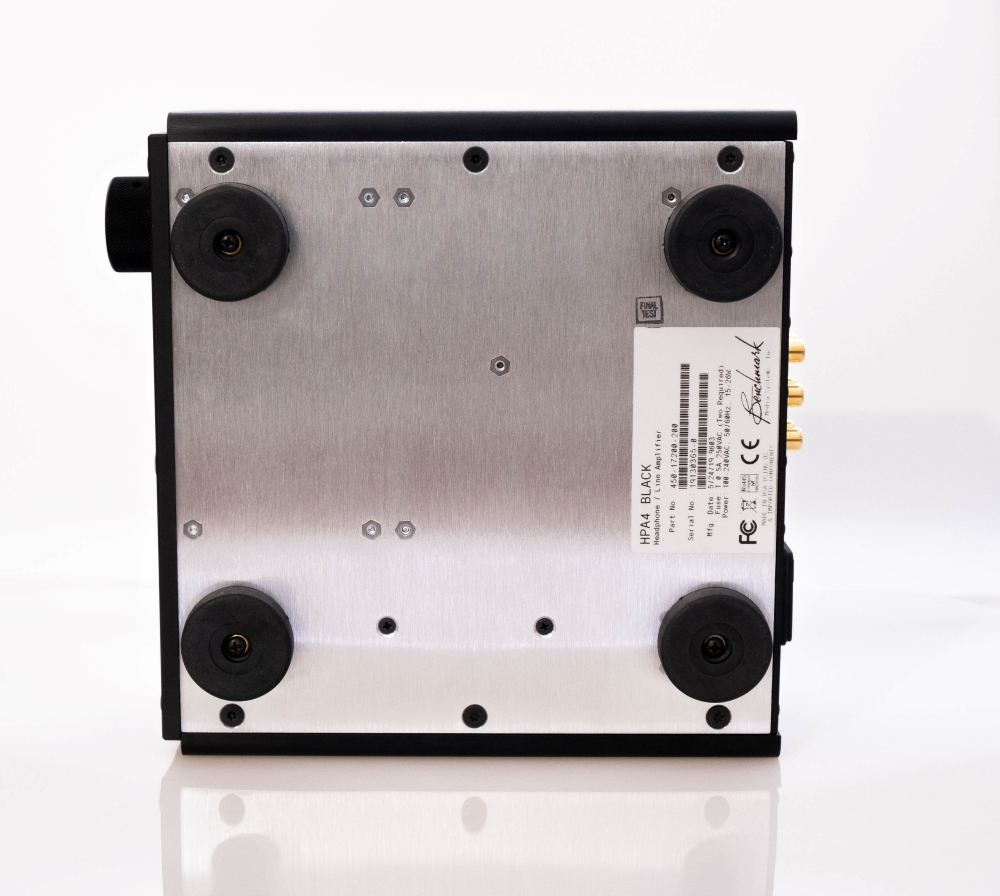
Conclusion
Before going into the conclusion, I again remind you: this is a loaner unit that will be returned and this is not a paid review, it is my own honest and humble opinion of this marvelous piece of equipment.
Put it simply this way: everything I ever dreamed a headphone amplifier should be and should do, I found in Benchmark HPA4.
It looks impressive and it is not stupidly huge and heavy (say Hello to Audio-GD Master-9), it is feature packed with tons of settings to play with, has 4 analog inputs from which 2 are balanced, has the best amp modules and the best volume control of any amp.
This headphone amplifier and line pre-amplifier receives my highest recommendation and scores the highest rank in my book.
There’s just one drawback that will put off a lot of people: it costs 3000 USD in USA (add another 100 USD for a remote) and about 3700 EUR here in Europe.
It spoiled me so much, that for the past 3 days I’m waking up at 5 A.M. so I can listen, tap my feet and head-bang just a little bit more. I for one, started saving for one, I’m sorry but I can’t go back to regular amps.
Without a doubt Benchmark HPA4 is an end-game, top of the line headphone amp – it’s The One to rule them All.
PROS:
- The most extended frequency response
- Deepest bass, most extended treble
- Zero harmonic or any kind of distortion even at 100% volume
- Mariana Trench deepness and open wide natural soundstage
- Genre Master: everything sounds exceptional
- Lightning quick transient response, slams like thunder
- Most natural fluidity and smoothness
- Most feature packed headphone amplifier on the market
- Magnum Opus in terms of headphone amplifier sound and design
CONS:
- The price tag
ASSOCIATED EQUIPMENT:
- DACs: Benchmark DAC3 HGC, Mytek Brooklyn DAC+, Matrix Audio X-Sabre Pro, Matrix Audio Element X
- Headphone amps: Benchmark HPA4, Aune S7 PRO, Erzetich Bacillus, Headamp Gilmore Lite Mk2
- IEMs: FiiO FH7, FA7
- Full-sized headphones: Audeze LCD-4Z, QUAD ERA-1, Sennheiser HD660S
- Portable headphones: Sennheiser Momentum M2.0, Meze 99 Classics
- Interconnects: QED Reference XLR (x2), Burson Cable+ PRO
- Power cables: Isotek EVO3 Premier (x2)






